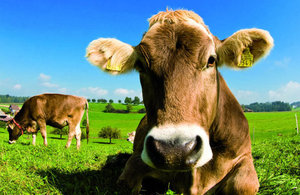CEN updates affecting chemical measurements (animal feed) September 2017
Changes to standards and technical documents updated by CEN that affect those carrying out chemical measurement in support of animal feed regulation

The following lists of standards were published by the European standardisation organisation, CEN, during the period June to August 2017, some of which are relevant to chemical measurement in support of regulation.
EN 16930:2017 - Animal feeding stuffs: Methods of sampling and analysis - Determination of carbadox and olaquindox by HPLC/UV
Carbadox and olaquindox are quinoxaline-N-dioxide derivatives and have been widely used in feed additives to prevent infectious disease and improve animal growth but are now prohibited in the EU.
This standard describes a method for the simultaneous determination of carbadox and olaquindox in compound animal feed and raw materials using high performance liquid chromatography with a UV detector (HPLC-UV) at levels up to 100 mg/kg. The limit of quantification (LOQ) in determining olaquindox is ≥ 3 mg/kg and for carbadox ≥ 4 mg/kg in animal feedstuffs and raw materials.
EN 16939:2017 - Animal feeding stuffs: Methods of sampling and analysis - Detection of tylosin, spiramycin and virginiamycin - Thin Layer Chromatography and bioautography
Tylosin, spiramycin and virginiamycin are macrolide compounds and have been widely used in feed additives to prevent infectious disease and improve animal growth but are now prohibited in the EU.
This EN standard describes a screening method using thin-layer chromatography (TLC) with a reported limit of detection ≥ 1 mg/kg to detect spiramycin, tylosin and virginiamycin in animal feed originating from plants but excluding mineral and pre-mixture feedstuffs.
For confirmatory purposes liquid chromatography coupled with a mass spectrometer (LC-MS) is required.
EN 16930 and EN 16939 have been developed in accordance with European Commission Mandate M/521 to prepare standards for the determination of food contaminants implementing the framework of Regulation (EC) No 882/2004 on official controls performed to ensure the verification of compliance with feed and food law, animal health and animal welfare rules.
EN 15510:2017 - Animal feeding stuffs: Methods of sampling and analysis - Determination of calcium, sodium, phosphorus, magnesium, potassium, iron, zinc, copper, manganese, cobalt, molybdenum and lead by ICP-AES
The elemental composition of animal feed additives and pre-mixtures is required to be known for the purposes of authorisation of certain feed additive compounds under EU legislation.
The elements calcium, sodium, phosphorus, magnesium, potassium, iron, zinc, copper, manganese, cobalt, molybdenum and lead are present in compounds used as feed additives or contaminants that should not be present above specified concentrations.
This EN standard describes extraction methods for the specified elements in organic feed additives using dry ashing followed by dissolution into hydrochloric acid or for inorganic feed additives by wet digestion using hydrochloric acid. For the determination of extractable lead in minerals and feeds containing phyllosilicates (e.g. kaolinite clay) wet digestion with nitric acid is specified. The concentrations of the extracted elements are determined by inductively coupled plasma atomic emission spectroscopy (ICP-AES).
The limit of quantification for each element is dependent on the sample matrix and the instrument used but should not be greater than 3 mg/kg for the specified elements with these methods and requires verification.
EN 15621:2017 - Animal feeding stuffs: Methods of sampling and analysis - Determination of calcium, sodium, phosphorus, magnesium, potassium, sulphur, iron, zinc, copper, manganese and cobalt after pressure digestion by ICP-AES
The elemental composition of animal feed additives and pre-mixtures is required to be known for the purposes of authorisation of certain feed additive compounds under EU legislation.
The elements calcium, sodium, phosphorus, magnesium, potassium, sulphur, iron, zinc, copper, manganese and cobalt are elements that may be present in compounds used as animal feeds and additives.
This EN standard describes an extraction method for the specified elements in animal feeds using pressure digestion. The concentrations of the extracted elements in animal feeds and additives are determined by inductively coupled plasma atomic emission spectrometry (ICP-AES).
The standard advises that for potassium and sulphur the method is more applicable as a screening method and not for confirmatory purposes.
The limit of quantification for each element is dependent on the sample matrix and the instrument used but it is estimated to be around 1 mg/kg for the specified elements.
EN 15510 and EN15621 are referenced in Commission Implementing Regulations for Regulation (EC) No 1831/2003 on additives for use in animal nutrition. Recent examples of Commission Implementing Regulations citing EN 15510 and EN15621 include the determination of total copper in the authorisation of copper(I) oxide as described in (EU) 2016/2261 and the determination of total zinc in the authorisation of acetate dihydrate, zinc chloride anhydrous, zinc oxide, zinc sulphate heptahydrate etc as described in (EU) 2016/1095.
EN 15550:2017 - Animal feeding stuffs: Methods of sampling and analysis - Determination of cadmium and lead by graphite furnace atomic absorption spectrometry (GF-AAS) after pressure digestion
The elemental composition of animal feed additives and pre-mixtures is required to be known for the purposes of authorisation of certain feed additive compounds under EU legislation.
The elements cadmium and lead are contaminants that should not be present above specified concentrations in compounds used as feed additives.
This EN standard describes an extraction method for cadmium and lead in animal feeds using pressure digestion. The concentrations of the extracted lead and cadmium in feed additives are determined by graphite furnace atomic absorption spectrometry (GF-AAS). For the determination of extractable lead in minerals and feeds containing phyllosilicates (e.g. kaolinite clay) wet digestion with nitric acid is specified
The limit of quantification is dependent on the sample matrix and the instrument used but is estimated for both cadmium and lead to be around 0.05 mg/kg.
Further information on food legislation can be found on the Government Chemist website: